Popular Wood Options For a Kitchen Dining Table
Choosing the right wood species for your kitchen dining table is such an important decision. This decision can greatly affect how well the table works for your family.
In this article, I will cover all the best wood options for a kitchen dining table. I will also cover all of the other factors that go into the decision, like cost, hardness of the wood, ease of working with the species of wood, and finishing options.
There is actually quite a lot that goes into choosing the right wood species for your project. I have learned a lot over the years of woodworking, specifically projects that include hardwoods. I have made many dining tables and have picked up a couple of helpful hints along the way.
I absolutely love building kitchen dining tables. Creating a space where memories are formed and friendships are made is one of my favorite things. I also love making things that are big, are a focal point in a room, and will get used for many years. I hope you enjoy making them as well!
My goal in this article is to provide you with all the information you need to choose what wood species is best for your dining table, whether you are building it yourself or purchasing a solid wood dining table from a store.
What is the Janka Hardness Scale?
Before we start, we need to talk about the hardness of hardwoods. The hardness is graded on a scale and that scale is called the Janka scale.
The range of numbers in the Janka Hardness Scale shows how much pressure is needed to make a dent in the wood. The higher the number, the more dense, hard, and durable the wood will be. In short, the higher the number, the less prone it would be to getting dents in the table top. So, it is one of the many important factors in choosing between different types of wood for wood tables.
It is commonly used when talking about wood flooring. However, I’ll be referring the the Janka scale when I discuss all of the common wood species for dining tables below.
Popular Wood Used for Dining Tables
First, let’s cover typical options of wood type for dining tables. The wood species mentioned below are the most commonly seen, and for good reason.
Walnut Wood
I’m going to start with walnut, because it is my absolute favorite. I’m giving away the ending now, but I believe it is the perfect choice for any dining table project.
Pros of Walnut
Walnut is gorgeous in its natural state. When a protective coat is applied to it, the color is a beautiful, rich brown. I love that it doesn’t have much of an undertone like red or orange.
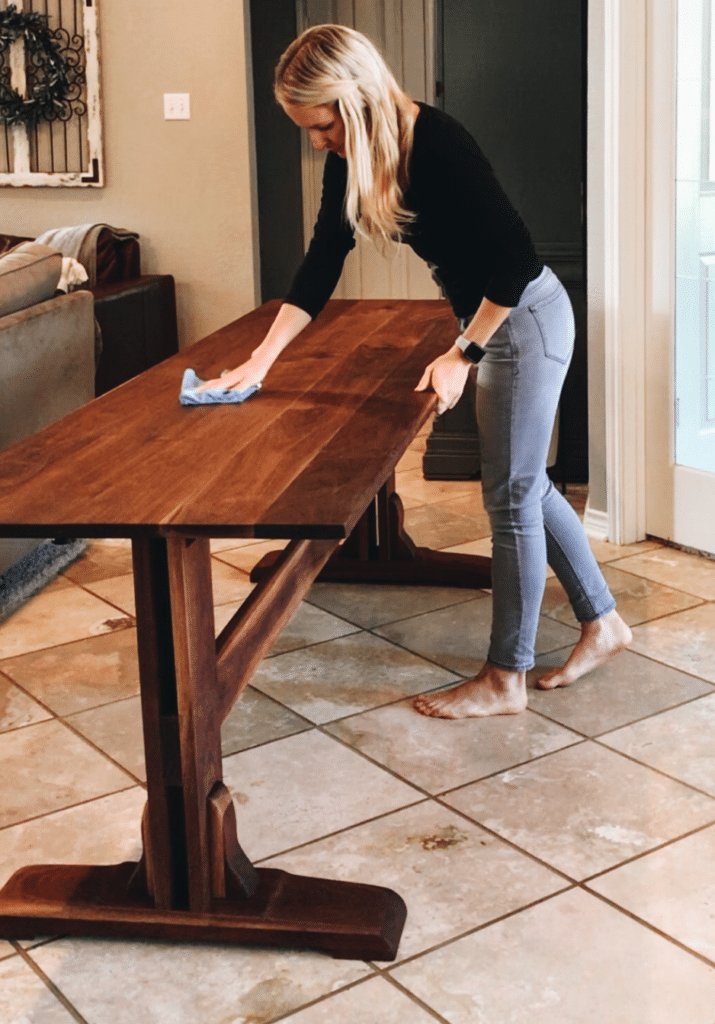
Walnut is, by nature, darker in color. I see this as a positive, because I love the color so much. However, if you want a lighter wood, this is not it.
Walnut has beautiful sapwood that I like to leave in my projects. The sapwood is the outer edge of the tree and is lighter in color. Some people remove this in order to have a more uniform table top. However, I love the look and the character tables have when the sapwood is used.
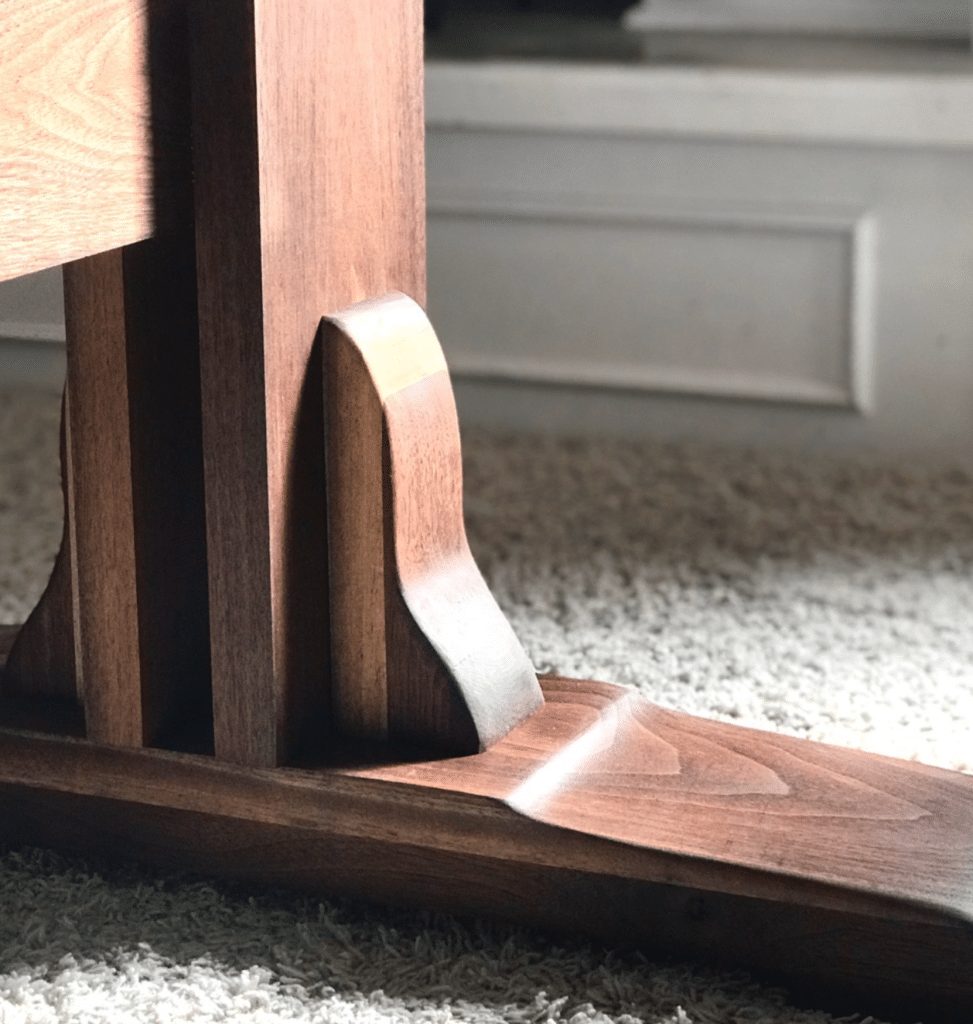
You can see the sapwood in the communion table I built below. The table was made for a specific corner, hence the shape.
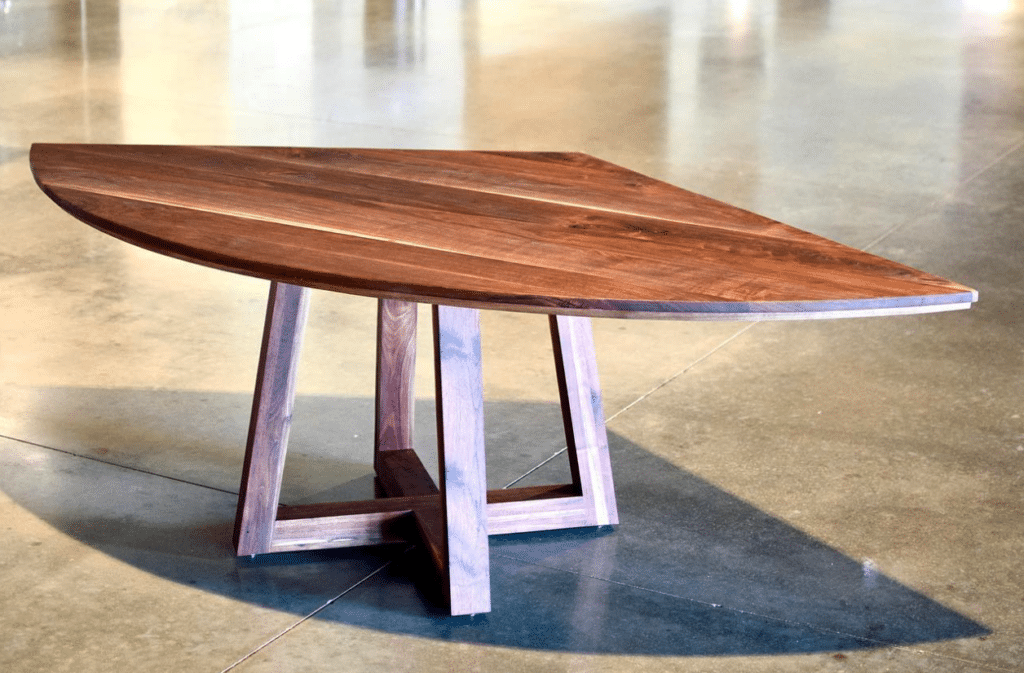
Janka Rating of Walnut Wood
Walnut has a Janka Scale rating of 1010. This makes it a moderately hardwood overall. Therefore, it will do a good job of resisting dents and scratches in your kitchen dining table, making it one of the most popular choices for dining tables.
Cons of Walnut
One downside to using walnut for a kitchen table is the price. Walnut is a very high quality hardwood, which in turn, means you will be paying for it. To give you a frame of reference, I built a dining table made completely out of walnut (tabletop and base included) and the materials came in just under $1,000.
However, you can build a table that will last for generations when you choose walnut. The cost is well worth it, in my opinion.
Where to Buy Walnut for Woodworking
I have had a lot of luck finding quality walnut on local sales online, like Facebook Marketplace and Craigslist. You can also check with your local lumber yard. If they don’t have it, you might be able to order it through them.
Lastly, join some local or state-wide woodworking groups online. Oftentimes, people are selling their hardwood stock online and that can be a great place to load up on things like walnut.
I personally lucked out with a garage sale where I got a garage full of a retired woodworker’s walnut stock. It had been harvested from Georgia decades ago and had been drying in his basement since then. I have built multiple tables and many, many cutting boards from that stash. Check your local sales!
Best Finish for a Walnut Table
My favorite way of finishing a dining table or cutting board made of walnut is with a sealer called Odie’s Oil. It is an all-natural, solvent-free, food-safe oil. It smells amazing and does an incredible job of protecting and sealing the wood. It brings out the most gorgeous wood and grain patterns in the walnut. I highly recommend it!
Pine Wood for Dining Table
Pine is a very common species of wood for beginner woodworkers. The reason is because it is cost-effective and readily available.
I wanted to cover this species of wood in this article, because it is so common for at home woodworking projects. I will also provide a couple of tips to take your pine projects up a notch or two.
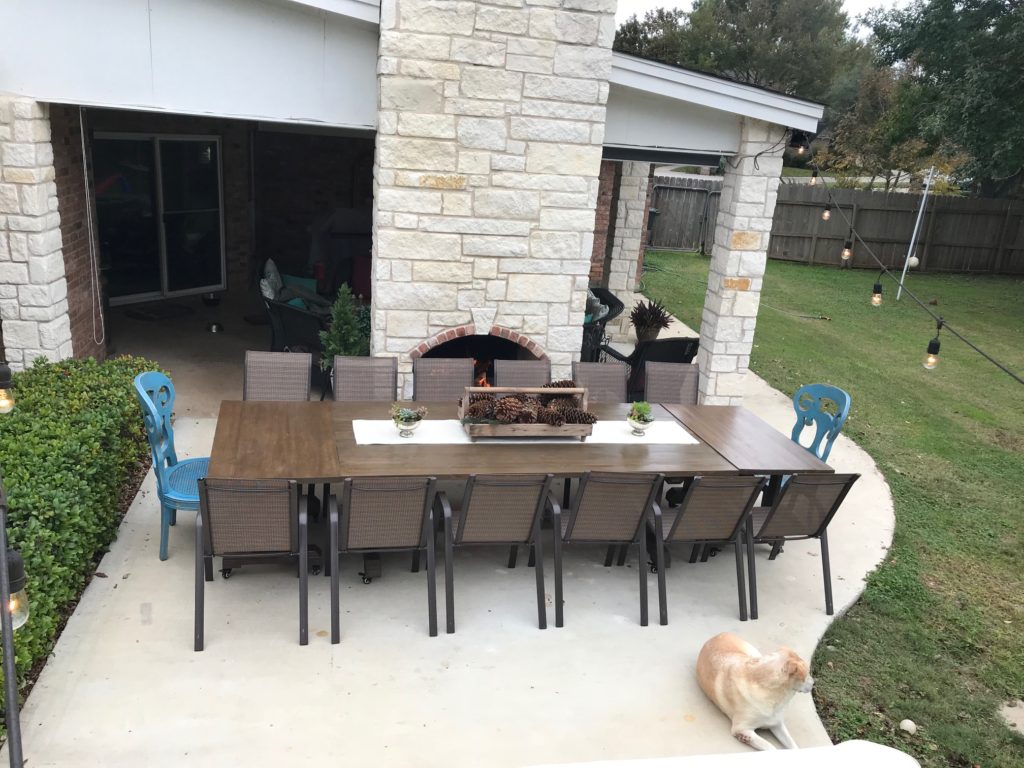
Pros of Pine
Pine can be found all major home improvement stores like Home Depot or Lowes. There are a lot of options available as far as sizes go, so this is enticing to many beginning woodworkers.
Oftentimes, woodworkers will have to dimension their hardwoods, like walnut or maple. However, pine comes in many different lengths and widths.
There is a good chance that the width of the pine from the big box store will be what you need for your project. That way, you will only need a miter saw to crosscut the length of wood to your desired length.
Pine is also the most cost-effective species of wood that I will cover here. You can build a whole dining table (base and tabletop included) for around $100, depending on the current price of lumber. That is far less than sourcing and paying for hardwoods like maple or walnut.
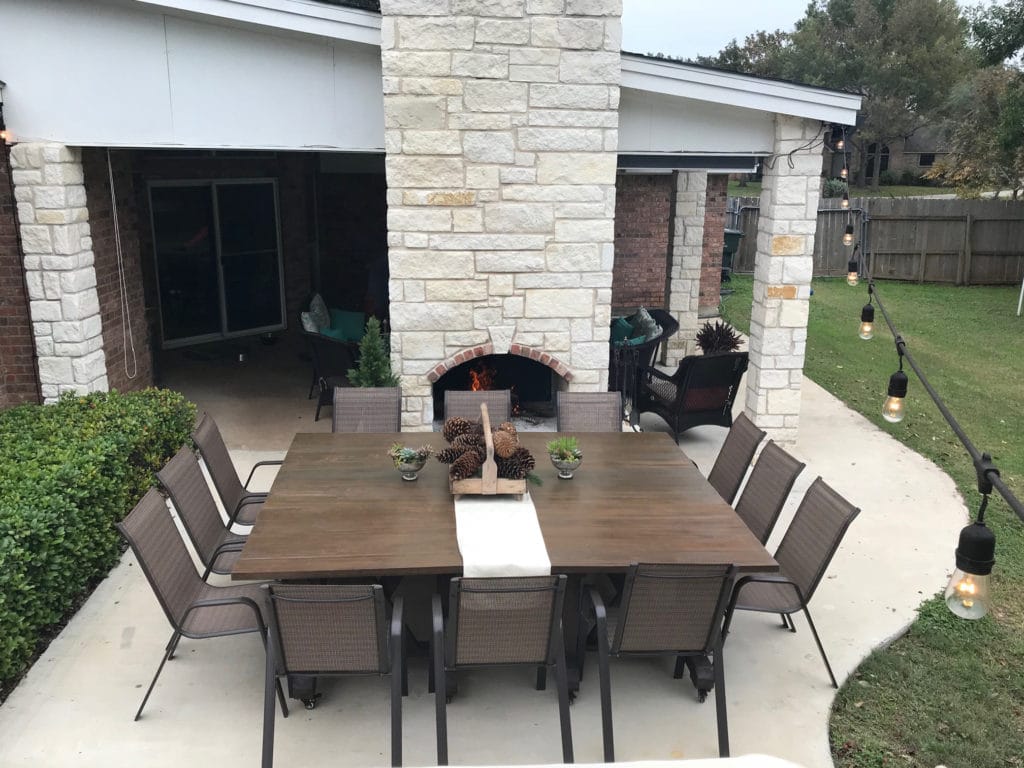
Janka Rating of Pine
The pine found at typical local hardware stores is about 420. There are other species of pine that are harder, but the typical white pine found at those stores are very soft.
The positive side of using softer woods is that it is easiest to work with. It will cut easier, and be more gentle on your tools. When you’re making a large table, this can make a big difference in work time and difficulty in building and assembling.
Cons to Using Pine for a Dining Table
Being that pine is so soft, it will easily get scratched and dented. It is not the most durable option for a dining table that might get heavy use.
Pine projects like dining tables probably won’t last as long as hardwood tables as well. Yes, you can make a quick and easy table that will function well for years. However, in the very long run, it won’t last as long as a hardwood table.
Oftentimes, pine from a hardware store hasn’t properly dried. Moisture in the wood can cause your project to warp or crack over time. It is best to properly dry wood in a kiln. You can also let it air dry in a dry place, although that takes a long time. The typical rule of thumb for air drying wood is 1 year for every 1″ thick the wood is.
Pine also won’t hold up well outside. Yes, I have built a few pine outdoor tables. However, even when it is sealed and stored under a patio roof, it will still crack and warp some.
How to Improve the Look of Pine Projects
Typical pine from a hardware store comes with rounded edges all down the length of the wood. When joined together on the edge, this would create a groove. On a dining table, this is a prime spot for crumbs to sit and make cleaning up a nightmare.
One of my favorite ways to fix this is to slice off the long edge in order to make a sharp corner on all the edge. This is called ripping the boards.
Making rip cuts in wood can be tough without the right tools. After ripping boards, you would want to make the new face of the wood perfectly flat so that the tabletop pieces sit flush together. This is called jointing a board, so that the seams in the tabletop fit perfectly together. Jointers are large and expensive and it’s not common for a beginner woodworker to have that tool.
You can see below the seams in the tabletop perfectly joined together. This is because the edges were jointed.
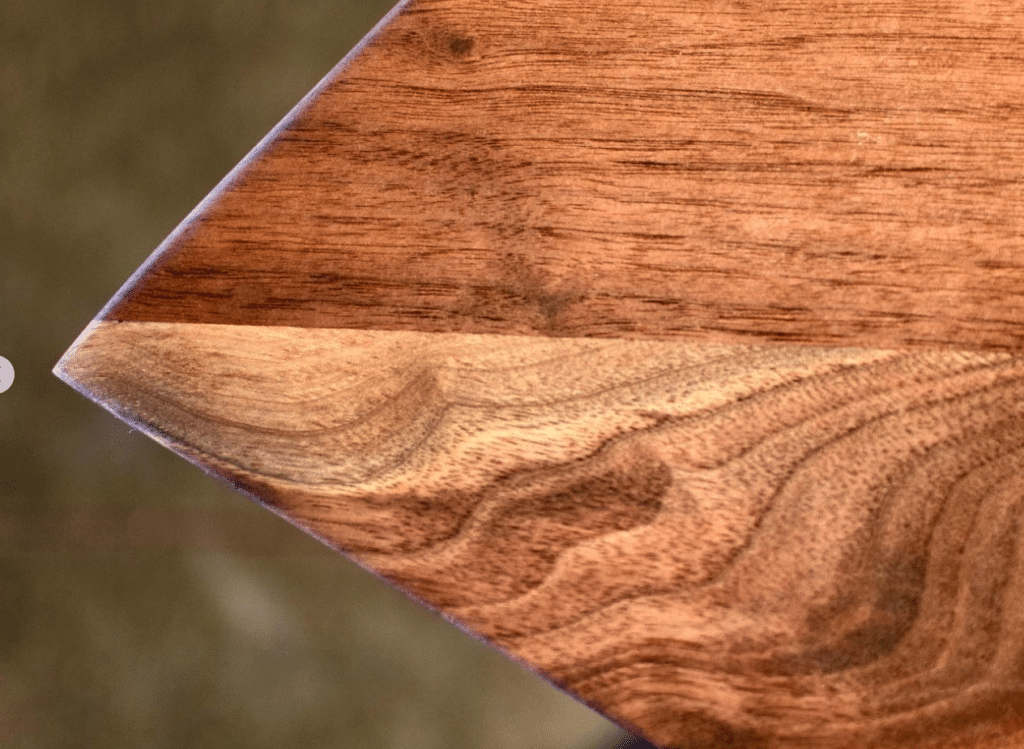
There are some methods that can make it easier to joint boards accurately when you don’t have a jointer, so check out the following articles if you’re interested: 3 Ways to Straighten a Long Board and How to Edge Joint Long Wood Boards.
Another way to improve the look of pine projects is to plane the pieces before you join them together. My planer and it has quickly become one of my favorite tools. It essentially shaves off the top layer of the wood, effectively removing imperfections and making it perfectly flat.
It is essential to creating cutting boards or any high-quality dining tables.
My last tip for improving the look of pine dining tables is to purchase select pine, rather than basic white pine. Select pine means that there are fewer imperfections and knots in the wood. This will make your dining table look a little better and create a more beautiful end product. It is slightly more expensive than the basic pine, but worth the extra cost in my opinion.
Pine is also typically stained. That is a potential pro to using pine – the many different shades of wood that can be achieved due to staining it. It is such a light wood, it shows it well, from lighter to darker stains. Find the color that fits your space best and stain it that color! The limit to hardwoods is that they aren’t typically stained, so you are stuck with whatever the natural color is.
Be sure to seal the table with a finish that is food-safe since the stain most likely will not be.
Tips for Buying the Right Pine from a Hardware Store for a Dining Table
Being that pine is milled in bulk in order to supply so many big box stores, it is likely that some boards will get in the mix that you don’t want to use for a dining table.
When I first started woodworking, I just bought the first pine boards I saw. Whatever was on top was what I bought.
Trying to work with poor-quality, warped wood with lots of knots will just be frustrating and not create quality work.
When looking at potential pine wood to buy, look down then length of the board like an arrow. This will show you if the wood is warped or twisted or not. If it is, go to the next board. Do this until you find a high quality board.
Also, be sure to look for wood that doesn’t have a lot of knots. Knots will more easily lead to the wood warping in the future. As I mentioned earlier, it might be worth it to pay slightly more for select pine, as this will have less imperfections and knots.
Due the the ease of access, price, and ease of working with the wood, pine might be an excellent choice for your wooden dining table. It could also be the best option for beginner woodworkers.
Maple Wood
Maple wood is a gorgeous species of wood that leans on the lighter side. It has a very smooth wood grain with a gorgeous finish.
The lighter colored wood in the peel below is maple, and the darker wood is walnut.
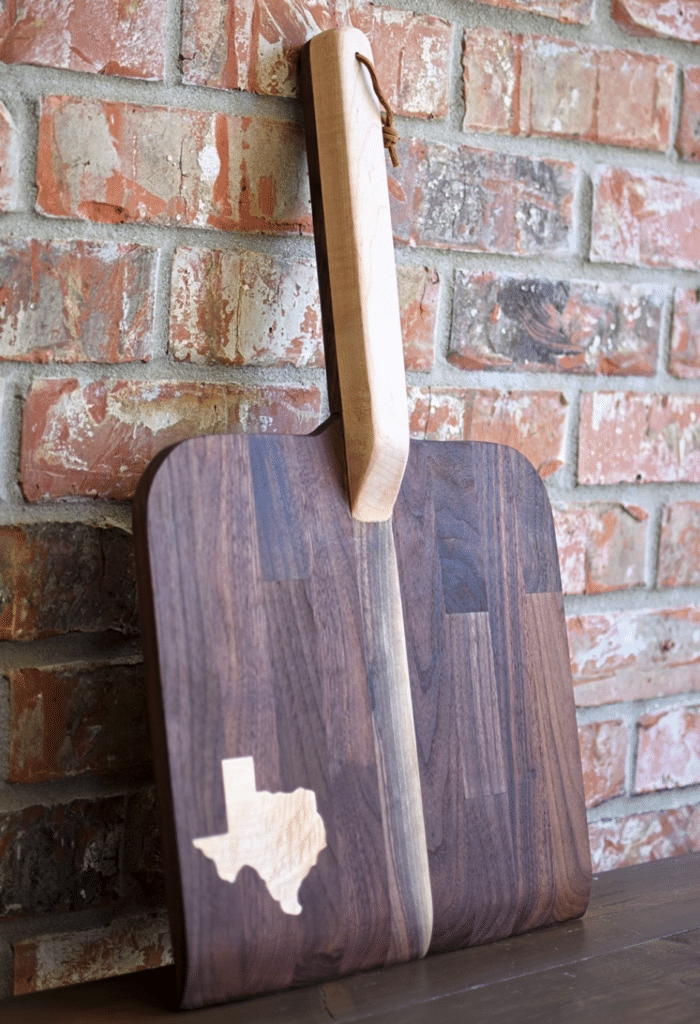

Spalted Maple
If you’re lucky, you can find a spalted piece of maple to build a dining table out of. Spalting is actually caused by a fungi in the wood, but it results in darker colors that follow the unique grain pattern.
This makes for a truly unique and gorgeous piece of furniture. You can see the spalting in the picture of the slab below.
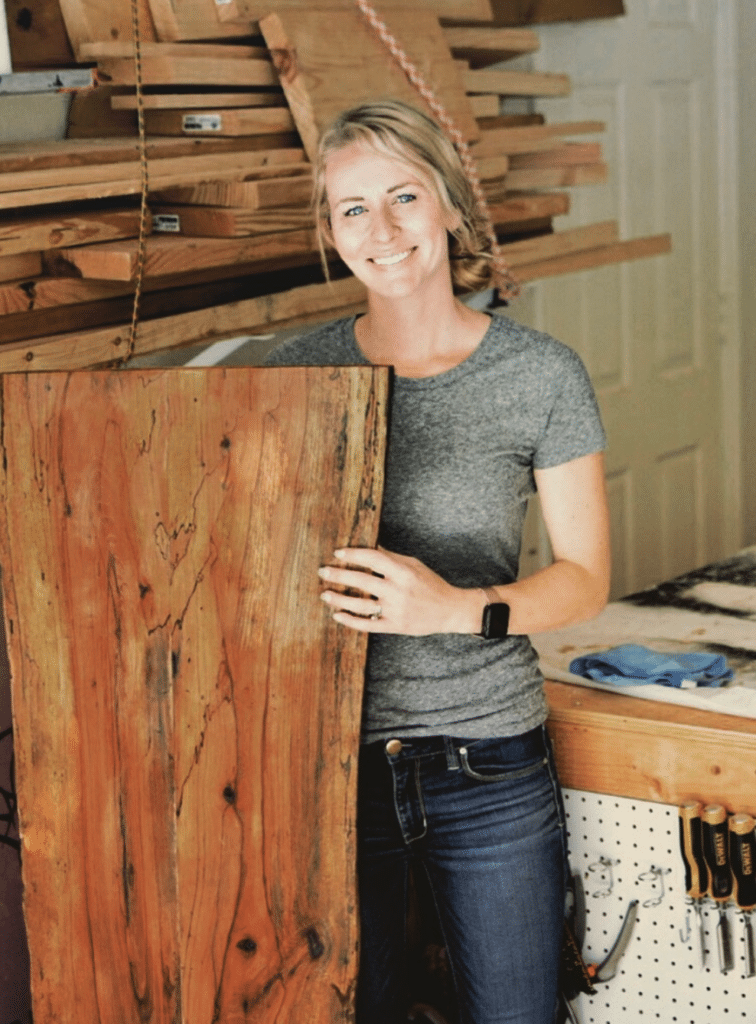
Pros of Maple
Being that hard maple is so light-colored, it would be a good choice if you want to keep your kitchen light and bright. Being that the grain pattern is so dense, it will make your dining table very durable to heavy use.
Cons of Maple
Maple can be hard on your tools, being that it is so hard. Additionally, burn marks can easily occur when you are milling the pieces for the dining table. This is due to both the hardness of the maple and the light color.
Maple is also expensive, especially compared to pine. It is typically comparable in price to walnut.
The Janka Rating of Maple Wood
There are different types of maple, but I will share the Janka rating of spalted maple: 1450. Compared the the hardwoods I will cover in this article, it is one of the more dense woods.
Maple will withstand heavy use and will resist dents and scratches well. This is especially true if you apply a sealer like Odie’s Oil.
Oak Wood
Oak is one of the most widely used and most popular choices for dining table wood. This is due to to the durability.
The picture of the charcuterie board below is oak wood, just to give you an idea of what the grain looks like.
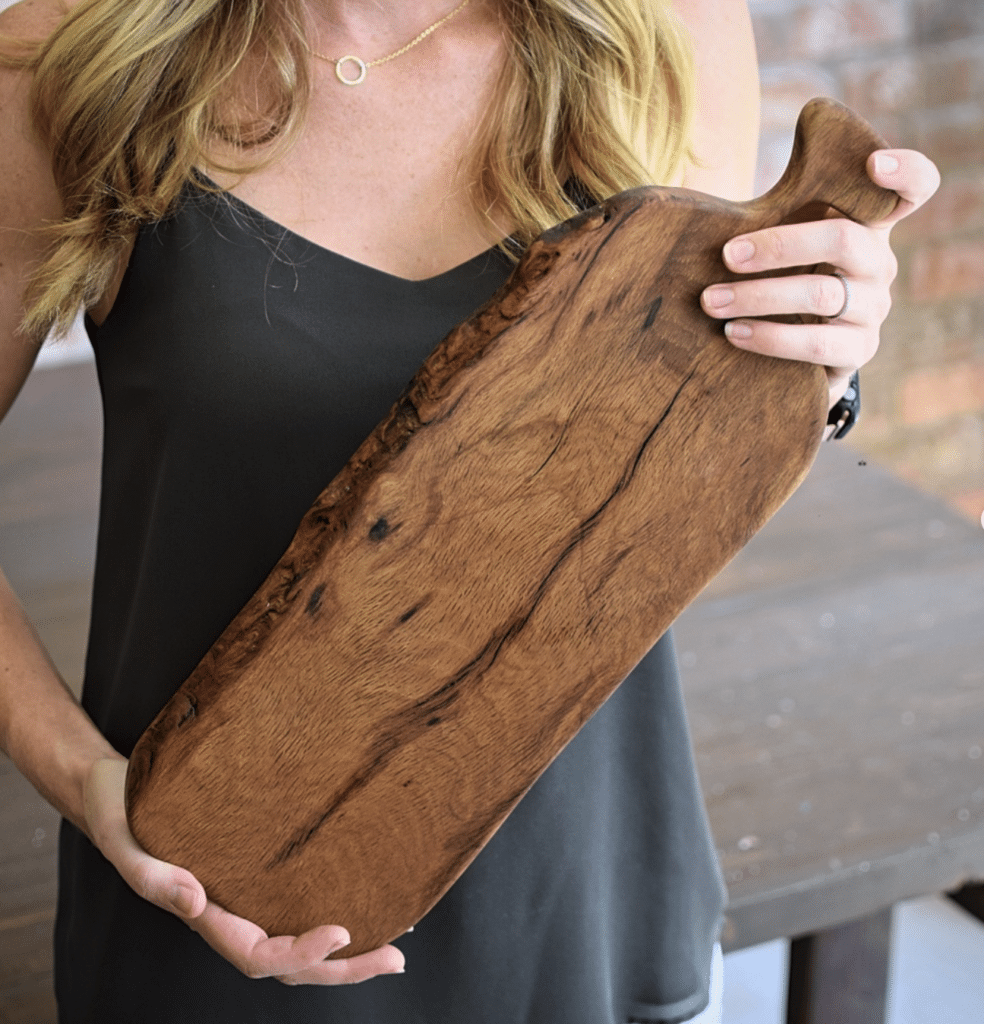
Pros of Oak
Oak dining tables will last for generations, due to the density of the wood. They are very popular, especially with the rise of farmhouse style.
It is also one of the more affordable hardwoods.
Cons of Oak
Some types of oak, especially red oak, can end up looking too orange in my opinion. I personally like a true brown or lighter color for my furniture and I try to avoid anything too orange if possible.
Oak is also very hard and can be difficult to work with. The end result will be very sturdy and durable, but the process of building might be a challenge.
Janka Rating of Oak
Depending on the type of oak you have, the Janka rating will fluctuate. However, most oak types are around 1400 on the Janka scale, making it comparable to maple. This makes it a very durable wood and very popular for wooden furniture. Oak is one of the hardest woods I will cover in this article.
Cherry Wood
Cherry wood is a beautiful option for a rustic look on your dining table. Due to the closed grain, it will be silky smooth when finished. It has a beautiful grain pattern that would look great when sealed or stained.
Janka Rating of Cherry Wood
Cherry wood would be a good option because of its hardness. It is not as hard as oak or maple, coming in around 950.
Pros of Cherry Wood
Cherry is very smooth and would be great for table tops and cabinets alike. It will be easy to maintain because of the closed grain pattern.
There is not much contrast in the wood, which is great if you prefer a more uniform look.
Cons of Cherry Wood
Because cherry is one of the softer woods I’m covering, it would be more prone to getting dents and scratches.
Depending on where you source cherry wood, it can be quite expensive.
Examples of Cherry Wood Projects
I wanted to provide you pictures of projects I have recently completed that uses cherry wood. This will give you an idea of what a cherry dining table might look like.
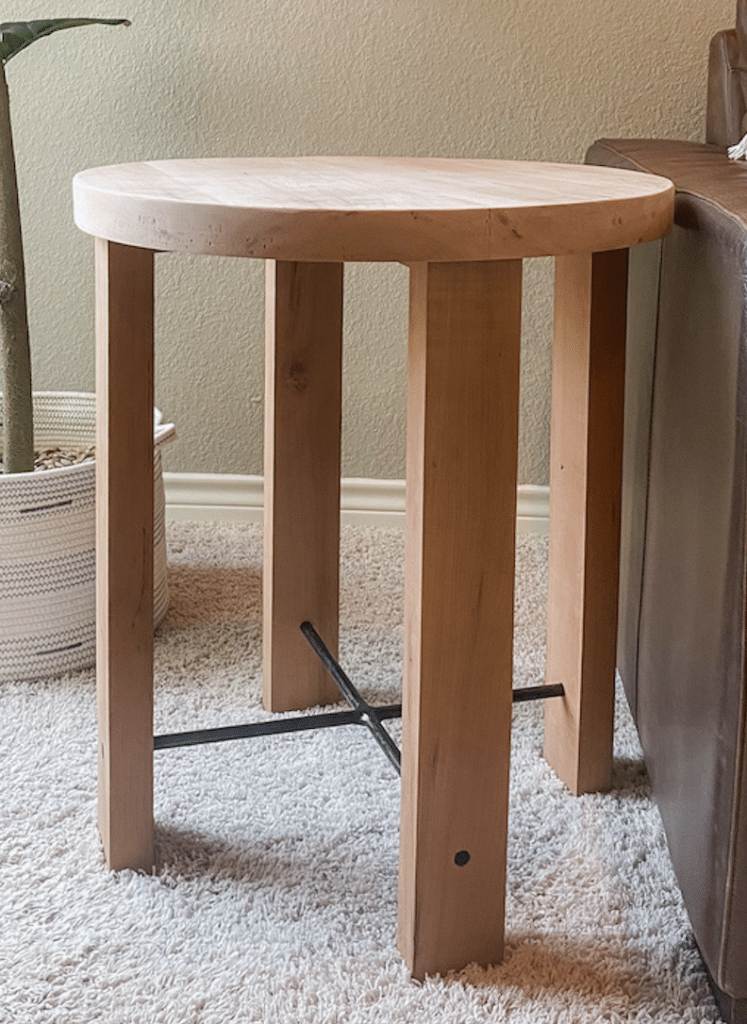
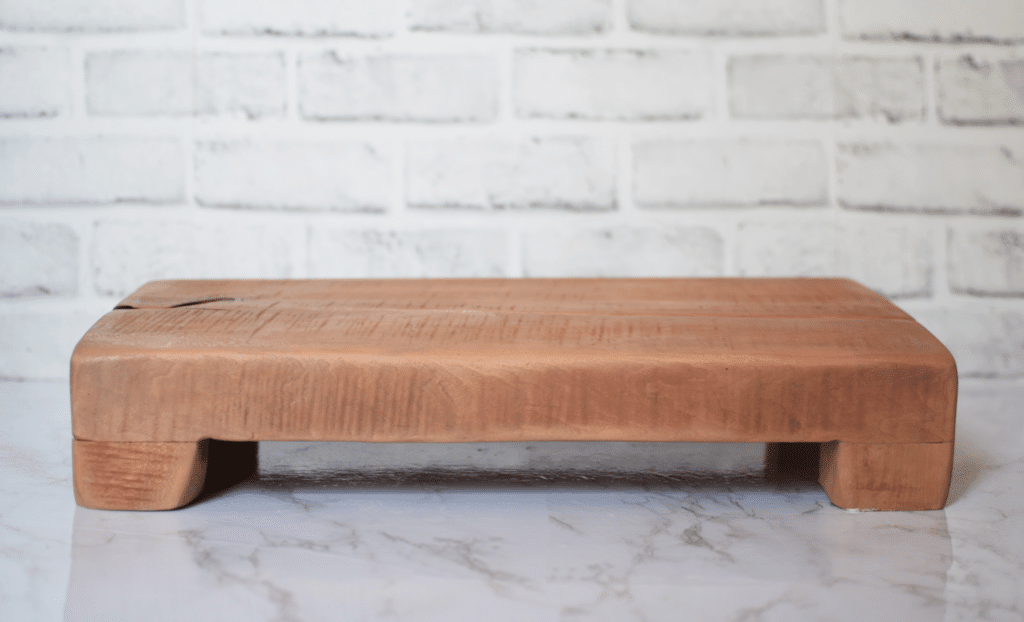
If you found this article helpful, be sure to check out the following articles:
- Best Finish for a Wood Kitchen Table
- Best Finish for a Wood Cutting Board
- Outdoor Wooden Modular Dining Table Plans
- How to Make a Wood and Concrete Dining Table
- How to Build a Large Square Coffee Table
- How to Build a Round Side Table
- How to Cut a Perfect Circle in Wood for a Dining Table
- DIY River Table

Suzie Wible
Suzie has shared her knowledge for over 10 years about building furniture, painting techniques, how to build your dream home, and basic to advanced woodworking skills. Through this blog, readers will feel empowered to create a home and products they love too.